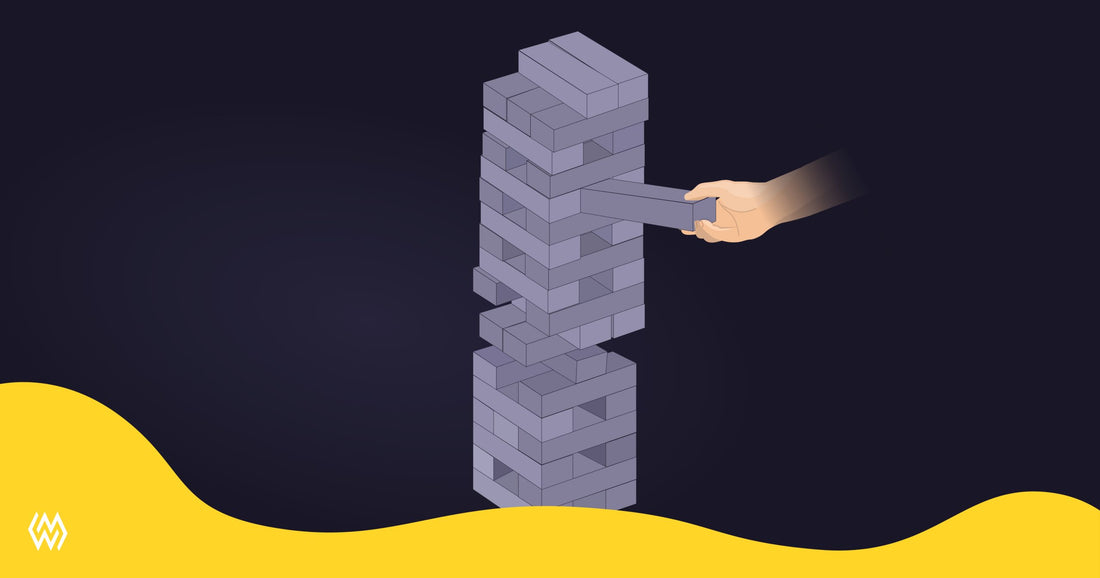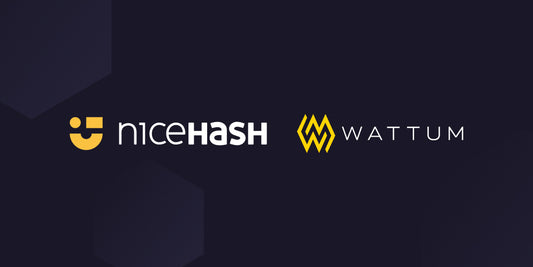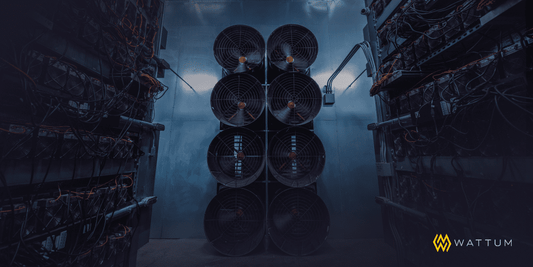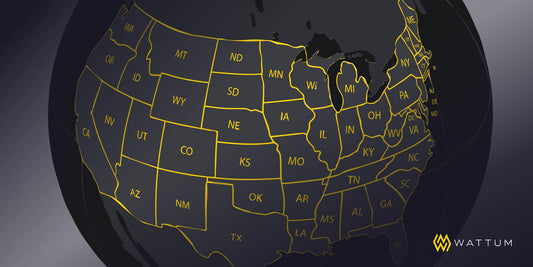Bitcoin mining is known as an innovative field that is constantly evolving and diversifying. With such innovations, many unexpected developments may occur, although not all of them will be welcomed with open arms.
When you first begin your journey in Bitcoin mining and purchase your mining equipment, you may likely be counting on a 24/7, 365 day uptime whilst relying on the expectation that you will be receiving Bitcoin every day. As soon as you experience your first disruption, many will jump into a “paper hands” mode by default. Paper hands is a term used in the crypto community to describe individuals who sell a digital asset, such as Bitcoin, at the slightest sign of turbulence in the market. This is the opposite of “diamond hands”, or ardent believers who are committed to holding their asset for the long term.
If your disruption is prolonged, you begin to count how much Bitcoin mining you lost in dollar values each day. This thought process may lead to thinking you’ll never make your money back, escalating to a panic for not having foreseen these risks, and pushing you down a rabbit hole that is not easy to climb out of. Having experienced the ups and downs of Bitcoin mining over the past four years, our own experience in mining has taught us ways to mitigate the effects of this cycle.
Understanding the risks of mining operations before you get into mining Bitcoin can help you avoid this stressful thought process, and will help you feel more prepared when unforeseen circumstances do arise.
Risks Associated with Maintaining Bitcoin Mining Uptime
Some of the key risks associated with hosting pertain to your mining equipment.
- Theft (Low Risk)
- While having your miners stolen is a very unlikely scenario, it should not be crossed off when structuring your mining operations. For the more risk-aversive miner, the best way to protect yourself against the risk of theft is to invest in additional insurance coverage for your miners at the facility where they are being hosted. Such coverage is a typically inexpensive investment in the United States.
- Fire & Flood Damage (Low Risk)
- This scenario is also unlikely, but again, it’s best to consider all potential risks. There have been rare instances where fires or floods have caused mining container operations to cease entirely, but additional insurance remains a secure option.
- Humidity Damage (Low - Medium Risk)
- Damage due to humidity is typically seen in the colder winter months, causing miner grills to rust and potentially degrading the performance of the miner’s control board and power supply.
- Heat Damage (Low - Medium Risk)
- Most common in warmer climates, heat damage degrades power supplies as they are not designed to run at over 85°F. Due to intense heat, control boards can begin to fail in the long run.
- Cold Damage (Low - Medium Risk)
- If a facility has poor heat circulation and outside temperatures dip below 30°F, it can create static that may surge the power supply and control boards, disrupting mining operations.
- Dust (Medium Risk)
- A seemingly small factor to consider, dust typically builds up on machines and can cause the miner to overheat if not cleaned properly. This can further degrade the soldering, causing the hashboards to overheat and fail.
- Immersion Damage (High Risk)
- If you are dipping your whole air cooled Bitcoin miner into immersion cooling, you have just reduced it’s lifespan from 5 - 7 years to 6 - 24 months. Old generation equipment that is planned for decommissioning, like the Bitmain S9 or Bitmain S17, can peacefully go to rest into an immersion cooling solution. If you send your new Bitmain S19 into it, you should be prepared to lose your whole investment without any regrets.
Properly functioning equipment relies on power supplies, so it is important to consider risks pertaining to such supplies as well.
- Wire Melting (Medium - High Risk)
- While hashboards are built to the same quality and standard as computer CPUs and can handle high levels of heat for extended periods of time without issues, the wiring on the power supply is not made to withstand the same conditions. The silicone on the power supply can slowly begin to melt until the wire becomes exposed, potentially causing a surge.
- Humidity (Medium - High Risk)
- Power supplies are very sensitive to static, which can be created and exacerbated by high levels of humidity.
- Power Connection (Low - Medium Risk)
- During the replacement of power supplies, the connection may be pushed in, causing the melting of the connector and further increasing the risk of a power surge.
- Power Surge (Low - Medium Risk)
- Multiple precautions are taken to avoid a power surge, but it can sometimes be tricky to avoid. The surge that caused damage to the power supply may actually be protection against the surge causing damage to the miner itself.
With consideration to both a power supply and mining equipment, one of the most important risks to consider in hosting pertains to the hosting facility itself.
- Burned Transformer (Low Risk)
- A transformer is essentially a very large miner, and it bears similar risks of a power surge and wire melting. There are a variety of components, between the utility power lines and the building or container that powers the miners themselves, that can break or get disrupted.
- Regulations / Load Shedding (Low - Medium Risk)
- Some location-specific regulations, such as those pertaining to noise or power restrictions, may affect the operations of a hosting facility. Some locations may not be zoned for industrial operations, putting restrictions on noise level permissions and causing issues with noise complaints that have on occasion turned into full-blown lawsuits. Some locations may also require a license to do Bitcoin mining but have never applied for one, and thus participate in illegal mining operations. This is one reason why it is very important to scope out both hosting and buildout locations with the help of a professional. Power restrictions, whether city-based or national, are also dependent on the location of a hosting facility.
- Utility Pricing Changes (Medium Risk)
- Utilities may see a price adjustment due to solar credits or gas prices increasing.
- Landlord Breach (Medium - High Risk)
- The landlord of a property where hosting operations reside may decide to breach the operating agreement, terminating your lease and potentially displacing your miners, or, as soon as your contract expires, force you to profit share or remove your equipment
- Degradation of Equipment (Medium Risk)
- Due to damage to hashboards, equipment may degrade and not produce a profit. Further, depending on the management of the hosting facility, the weather, and the quality of the manufacturing batch, hashboards may break as a result of poor maintenance.
As you can see, any number of scarce or unforeseen factors may affect and disrupt your Bitcoin mining operations. While 100% uptime may be desirable, the accepted rate of Bitcoin mining is 70% - in fact, many large global self mining operators will accept an uptime rate as low as 60% when negotiating with suppliers for a large number of megawatts. This is typically pre-negotiated with the utility company using a Power Purchase Agreement (PPA), which would keep the power purchase low if both parties agree to shed load, when demand outstrips the supply. Utilities in states such as Oklahoma and Texas are willing to drop the rate per kWh if you are willing to shut down your mining farm when there is an increase in power demand from the utility that will use the power for their non Bitcoin mining customers. This is the same load shedding method that is used in Kazakhstan. Some accept it after the fact, when they think they have received a very good power rate and then realize they are up half of the time. For customers that know about these risks, they are proactively offering profit sharing on their own self mining to the hosting provider that is willing to offer a service level agreement, ensuring a 90%+ uptime rate.
Those looking for a 97% uptime guarantee may invest in the facility infrastructure themselves, or opt in to a profit-sharing model at the facility that can guarantee service at such a high level. Investing in facility infrastructure would allow more control for the operators to achieve the 97%+ uptime rate. Coin mint offers profit-sharing that can amount up to 25% of your total mining revenues, which would make your per kWh cost range from between $0.13 to $0.18/kWh depending on where Bitcoin is trading in exchange for a better service level agreement.
Such risks associated with hosting affect even the most seasoned of miners. As dedicated professionals and crypto enthusiasts ourselves, Wattum has felt the effects of the recent situation in Kazakhstan, with our own miners residing at the Enegix facility located in the region. Enegix has had over 4 years of uninterrupted Bitcoin mining operations and has shown continuous expansion during this time. Other close associates of both Enegix and Wattum, who have experience running over 400MW capacity facilities since 2017, were also situated in Kazakhstan, making the most of a well-researched opportunity that has temporarily gone awry.
Kazakhstan has always had a surplus of unused power prior to March 2021, and has never experienced such an overload until now. As a result of increased interest in the region for mining, facilities with existing infrastructure that had 100MW of power but were only using a small portion of it began unauthorized Bitcoin mining which prompted the passing of a law, outlining that anyone practicing self-mining must be registered. This law was not actively enforced, resulting in 1200MW of power being turned on between August and September 2021, without any registration being completed. In November 2021, the Kazakhstani government began enforcing the law against unauthorized Bitcoin mining, and has shut down such operations until registration is completed and then permitted to resume.

As a result of the hash rate migration out of China, following regional crackdowns on Bitcoin mining operations in June 2021, Kazakhstan has seen an increase in the global hash rate share with a 10% jump from July 2021 to August 2021, claiming second place with a 21% share, right behind the United States in first place with 41%.
An option that we have surfaced and continue to stand by is to ride out the ongoing Kazakhstan situation; the innovative nature of Bitcoin and crypto extends to the means by which we develop our ability to keep innovating, further speaking to our desire to diversify Bitcoin mining in Kazakhstan.
How to Diversify your Risks during Downtime
In order to avoid a loss of mining profits, you need to diversify where you host your miners. Wattum has multiple available locations and is open to hosting between 10 and 100 of your miners across more than one facility in order to ensure that, should one facility go down, it does not take the entirety of your Bitcoin mining operations down with it.
If you already have purchased miners, you can acquire additional units to host at one of our facilities or swap your existing units out to one of our locations.
Understanding the Value of your Bitcoin Mining Asset
It’s easy to become lost on the true value of your Bitcoin equipment, like the Bitmain S19, when you’re dealing with a disruption and have entered paper hands mode. You assume that all is lost if the machine is not mining Bitcoin, however, the mining hardware itself has value, and depending on when you bought it (and when you plan to sell it) you can time your decision just right in order to make a lucrative profit. Yes, even if the machine doesn't mine any Bitcoin.
The Bitmain Antminer S9 (13.5TH) sold for between $80/TH and $180/TH in late 2017. In late 2018, during the bear market, it was selling for $2/TH - in fact, we’ve seen them go for free as long as someone was willing to pick them up or pay for shipping. In 2021, a used unit that had been going for free was selling for $35/TH and $70/TH when it was already a 4-year old machine. You can still find S9’s for sale, solidifying the fact that these machines have a lifetime that exceeds 5 years, and that their value cycle can fluctuate just as much as that of Bitcoin itself.
In fact, if you look at the relationship between the price of Bitcoin and the price per TH for a Bitcoin miner, they typically follow each other with a 90% correlation. The one upside is that a Bitcoin miner often has a 7 day to 14 day delay before it catches up to the BTC price correlation. Ultimately, this gives you an extra 7-14 day safety NET to buy or sell Bitcoin through a Bitcoin miner.
So, if a Bitcoin miner is similar to holding Bitcoin, what would Bitcoin mining actually be considered as? Well, it would be considered as earning an interest on your asset, and measured as an annual percent return (APR). Bitcoin mining can allow you to earn interest as high as 100% if measured at any given moment. You can compare that to only 12% APR that you can earn on holding just Bitcoin in a earn interest account platform like Nexo.io. If you mine Bitcoin, you can still put it into an earn interest account platform and ultimately increase your APR even further.
If you see a Bitcoin miner as your Bitcoin, and your Bitcoin mining as your earn interest, then similarly to how Nexo is the earn interest platform to Bitcoin, your colocation partner can be thought of as an earn interest platform for your Bitcoin miner. A place for storing your Bitcoin machine that earns your Bitcoin through a Bitcoin miner. This is why it’s important to work with a reputable colocation partner. You pay your colocation partner a colocation fee, and in exchange they power and manage your Bitcoin miner so that it makes an APR on your Bitcoin miner asset. If the colocation facility is not working or performing to your standards, then you move your equipment to another colocation facility.
If your colocation partner is not reliable, unless otherwise stated in your service level agreement, it is not their responsibility to pay you out for your Bitcoin mining losses when a disruption happens, nor is it their responsibility to relocate your miners if they are not performing up to aforementioned standards. This is one of the reasons why some miners choose to pay higher colocation fees or participate in profit-sharing at the facility, and in exchange get a guaranteed service level agreement so they can minimize disruptions and even get reimbursed for any downtime. If you are a regular colocation customer that does not have a profit sharing agreement or a favorable service level agreement, then your expectation should be that you are on your own in terms of the colocation facility’s performance, and that if a disruption should occur, it is something you should be prepared for by either readjusting your expectations or diversifying your Bitcoin mining operations.
So, while it may be disappointing when you don’t receive your APR from holding Bitcoin through a Bitcoin miner, it’s not the end of the world. It is likely that you will still get a very high APR when you blend your uptime and downtime, which may exceed 50% APR, and it is the best you’ll get when you compare the ROI on any other asset class. Bitcoin mining even during downtime is still a good investment, but, more importantly, your Bitcoin miner is a Bitcoin Asset just like Bitcoin itself, so even if it is not mining at all, as long as your Bitcoin miner is safe and secure, your investment is safe as well.
It’s important to plan for how long you would like to hold your Bitcoin asset, the minimum of which is typically 1 year. However, most experts, including ourselves, would recommend that you hold your asset for up to 3 years. If you can time your investment ideally to predict a major shift in the market, one which would redirect Bitcoin from a bullish direction into a long term bearish direction, then you would be able to cash out your investment before it happens, and then buy the dip. You can also let the full cycle play out and mine Bitcoin in the meantime, and then once the next bull run occurs, which has happened regularly over the last 10 years, you would sell your Bitcoin miners and cash in your Bitcoin at that time.
The Time Isn’t Always Right
Having been in the crypto game for some time, Wattum has had its own fair share of hard lessons. In 2018, for example, we purchased GPUs for $4,000 and saw their worth drop steeply to $650 over a 2 year period.
We waited 2 years, and at the first sign of an interested buyer, who offered $950, we sold them all. Had we simply waited 6 to 12 more months, marking 3 years since our original purchase, we would have seen the same used machine’s value jump to $12,000 each. We could have mined during that entire period with 50% uptime in 2018, 40% uptime 2019, 70% uptime in 2019, and 100% uptime in 2020, and then made a sale for triple the amount we paid for the GPUs while also cashing in the coins that we would have mined.
Our experience with the Bitmain S9 was the same: we purchased the majority at a blended cost of $750, sold them all at $350, and by simply waiting one extra year, could have been mining and then selling the same used (and now even older) units for between $750 and $1,000. However, a hard lesson learned is a lesson for life.
If you are not mining with 100% uptime, don’t fret. This is a unique opportunity to fully understand this article, use this information to your advantage, and to begin creating a game plan for when you’ll be exiting, and when you’ll be buying the dip.
Depreciation and Appreciation
If Bitcoin goes up and difficulty is stable, your Bitcoin miner will appreciate in value. This means that you can buy a miner for $100/TH when Bitcoin trades at $60,000, and if the price of Bitcoin hits $100,000 and equipment sells for $180/TH, you can sell your unit at $150/TH and book a 50% profit. This is on top of any Bitcoin mining that you did that would be considered your APR on holding this Bitcoin mining asset.
Even if your equipment is used, miners have 4 tiers of deprecation. The way these tiers work is simple: it begins with the retail value of the brand new unit, and follows a downward trajectory from that point to tier 1, tier 2, and so on. This means that if a brand new unit increases in price (and it may if Bitcoin goes up and difficulty is stable) then your resale price would be the 2nd tier from the original, brand new value of the unit. If you just bought your unit today, you are immediately depreciated to tier 1, and just like driving a brand new car out of the dealership, the value drops by up to 15% or more from the original price. The 2nd tier in this model is soon to follow within about 3 months of this initial drop, so if you are trying to sell a unit that is 1-2 months old, it should be expected that you would be offered tier 2 pricing. By selling your units on eBay or Amazon, you may be able to receive a tier 1 pricing offer, and may potentially even receive a match for the brand new, original price you paid.
While the value of your asset can appreciate, it is still computer equipment and can be fully depreciated in the United States on your income tax.
When to Buy and Sell Bitcoin Miners
The easiest way to purchase a Bitcoin miner is just like purchasing Bitcoin itself: you buy a miner if you think Bitcoin is going up, and when it reaches your target price, it is the ideal time to sell your Bitcoin miner.
If you think Bitcoin will go up even higher, you can buy BTC directly with the profits you made from selling your mining equipment. In theory, you can trade your Bitcoin miner as often as you would trade your Bitcoin. One of the known superiorities of the Bitcoin space is in fact the ability for such transactions to come full circle, further empowering your mining operations along with your place in the crypto landscape.
Your position and success in the crypto world is further supported by working with the right partner across equipment acquisition, hosting and management services, and even build out and location sourcing. The Wattum team offers all of these services and more as a part of our end-to-end solutions model, which aims to support both novel and seasoned miners in their Bitcoin mining operations as well as keep them educated and up to date on mining best practice, including risk awareness and uptime expectations. Amidst sweeping recent developments in Bitcoin, such support and trusted service has never been more valuable. Get in touch with us today.
Lessons Learned
Diversify, diversify, diversify. Wattum hasn't offered this option until now as we did not have reliable partners across different countries that we trusted to deliver the standard of service that we expect and hold ourselves to, like we do now. Today, we have locations across the United States, Russia, and Kazakhstan with battle tested partners, such as Enegix in Kazakhstan, that we trust to deliver the service we want for ourselves, and for our customers.
These three Bitcoin mining hubs, according to recent data gathered by the University of Cambridge, are currently among the top countries for hash rate share following the well-documented crackdown and resulting dispersion in China, in June 2021. Since August 2021, the U.S. holds a hash rate share of 42.7%, with Kazakhstan at nearly 21.9% and Russia just below 13.6%.
Say you are buying 30 Bitcoin miners and sending them across various available locations. Even if there are multiple locations in the United States, split them up. Don’t put all your miners into one basket. This is the best way to de-risk your downtime and maximize your uptime, so that you can make the highest APR possible by holding your Bitcoin miner asset.
Having spent some time learning these lessons ourselves, the Wattum team is dedicated to ensuring that our customers are equipped with the same important information in order to make informed decisions for their Bitcoin mining operations. Should you have any further questions, comments, or need clarification on any of the points discussed in this article, please do not hesitate to get in touch with your Wattum Sales Representative, and they will be more than happy to assist.



